


Some less well known chemistry of selenium
The chemistry in some sense resembles that of sulphur, but there also are remarkable differences. Some aspects of the chemistry of selenium are not known very well and certainly cannot be regarded as common chemistry.
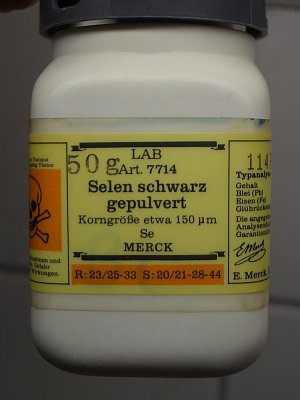
In this experiment, a sulphur-selenium compound is prepared in solution, which most likely can best be compared to polysulphide, but in literature, there is no mention of such compound.
Another compound is prepared, which most likely is selenium oxybromide.
Selenium can be purchased in the form of small corpuscles or in the form of a very fine black powder. Both forms of selenium are the same allotrope, the dark grey allotrope, which does not dissolve in any solvent without reaction. In the experiments, described in the first part of this web page, a high quality sample of selenium is used, as shown in the picture above.
![]()
![]() Required
chemicals for part 1 of this webpage:
Required
chemicals for part 1 of this webpage:
-
selenium
-
sodium sulfide
-
dilute sulphuric acid
-
sodium hydroxide
-
sodium peroxodisulfate
![]() Required
chemicals for part 2 of this webpage:
Required
chemicals for part 2 of this webpage:
-
sodium selenite
-
selenium dioxide
-
moderately concentrated hydrobromic acid (40% by weight)
-
sodium hydroxide
-
sodium sulfite
![]() Required
equipment:
Required
equipment:
- test tubes
- small beaker
![]() Safety:
Safety:
- Moderately concentrated hydrobromic acid and dilute sulphuric acid are corrosive.
-
 The soluble
compounds of selenium are exceedingly toxic and there is a risk of
cumulative effects. Be 100% sure that there will be no exposure at all to
these compounds!
The soluble
compounds of selenium are exceedingly toxic and there is a risk of
cumulative effects. Be 100% sure that there will be no exposure at all to
these compounds! - Sodium sulfide and sodium hydroxide both are strongly alkanine and as such are very corrosive to skin and especially the eyes.
- Sodium sulfide has a horrible smell of rotton eggs and at low pH the sulfide is released as hydrogen sulfide. In this experiment, the amount of used sulfide is too low to allow dangerous concentrations of hydrogen sulfide, but the horrible smell definitely will be noticed, unless one works in a good fume hood.
![]() Disposal:
Disposal:
- Do not flush the solutions in the sink. Keep them until they are brought to a proper chemical waste processing facility.
![]()
Part 1: A selenium-sulfide anionic species
When selenium is added to a solution of a sulfide at sufficiently high pH, then the selenium slowly dissolves and a deep red solution is obtained. Probably the selenium only dissolves when free sulfide ion is available, hence the need for a sufficiently high pH. Plain sodium sulfide is capable of dissolving the selenium, its solution contains sufficient sulfide ion.
The experiment can easily be carried out:
![]() Take a
small amount of selenium (a few tens of mg is sufficient) and take a spatula
full of sodium sulfide. Dissolve the sodium sulfide in water, and add this to
the selenium.
Take a
small amount of selenium (a few tens of mg is sufficient) and take a spatula
full of sodium sulfide. Dissolve the sodium sulfide in water, and add this to
the selenium.
![]() Swirl
the solution carefully for 5 minutes or so. The selenium slowly dissolves and
finally one obtains a clear deep red solution.
Swirl
the solution carefully for 5 minutes or so. The selenium slowly dissolves and
finally one obtains a clear deep red solution.
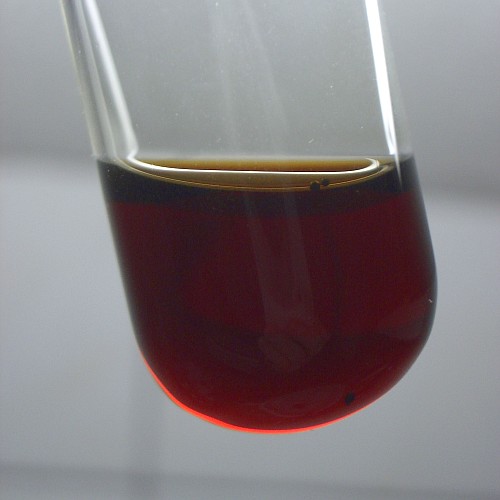
The picture above shows some of the solution in a wide (28 mm) test tube. It shows how dark the solution is, even with the very small amount of starting material.
![]() A few tenths of ml of the above solution were further diluted
and put in a standard (18 mm) test tube with three times its volume of water.
This results in a clear red/brown solution. This sulfide/selenium anionic
species has a beautiful color.
A few tenths of ml of the above solution were further diluted
and put in a standard (18 mm) test tube with three times its volume of water.
This results in a clear red/brown solution. This sulfide/selenium anionic
species has a beautiful color.
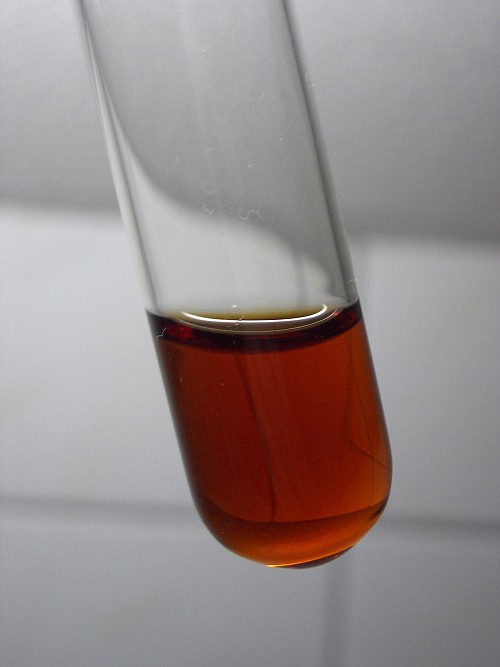
When this solution is diluted much more (by pouring it in a beaker, filled with water), then it partially decomposes, giving a yellow/brown solution, which is not totally clear.
Selenium-sulfide anionic species unstable at low pH
![]() The selenium-sulfide anionic species is unstable at low pH.
This is nicely shown when the clear brown/red liquid (as shown above in the last
picture) is acidified with some dilute acid (e.g. 10% to 20% sulphuric acid).
The selenium-sulfide anionic species is unstable at low pH.
This is nicely shown when the clear brown/red liquid (as shown above in the last
picture) is acidified with some dilute acid (e.g. 10% to 20% sulphuric acid).
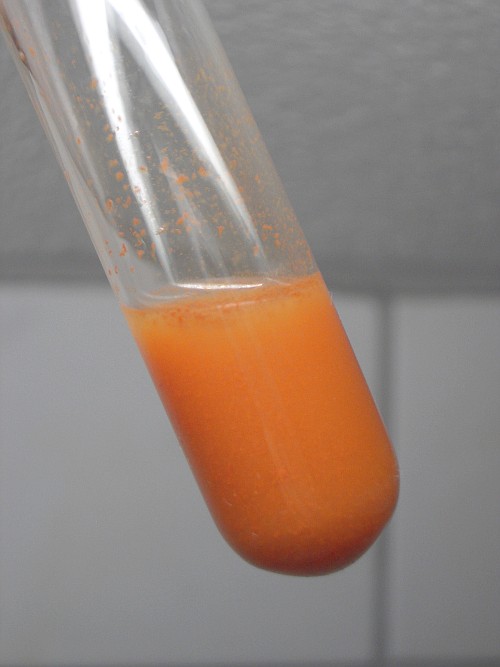
An orange precipitate is formed, which clumps together at the bottom in larger orange/red/brown lumps.
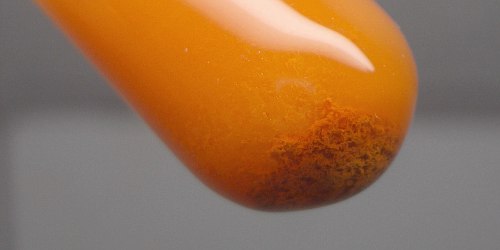
![]() When this precipitate is heated, then it darkens somewhat to
a more reddish color and the particles are clumping together even more.
When this precipitate is heated, then it darkens somewhat to
a more reddish color and the particles are clumping together even more.
Selenium can be oxidized easily
![]() The precipitate in the hot solution easily dissolves when a
peroxodisulfate is added as oxidizer. On addition of excess sodium
peroxodisulfate, the precipitate quickly becomes much lighter in appearance
(probably because sulfide is oxidized to sulphur, which also precipitates) and
after this, it dissolves, until the liquid is almost clear and very pale yellow.
The final color, however, and also the final remains of turbidity, do not appear
easily.
The precipitate in the hot solution easily dissolves when a
peroxodisulfate is added as oxidizer. On addition of excess sodium
peroxodisulfate, the precipitate quickly becomes much lighter in appearance
(probably because sulfide is oxidized to sulphur, which also precipitates) and
after this, it dissolves, until the liquid is almost clear and very pale yellow.
The final color, however, and also the final remains of turbidity, do not appear
easily.
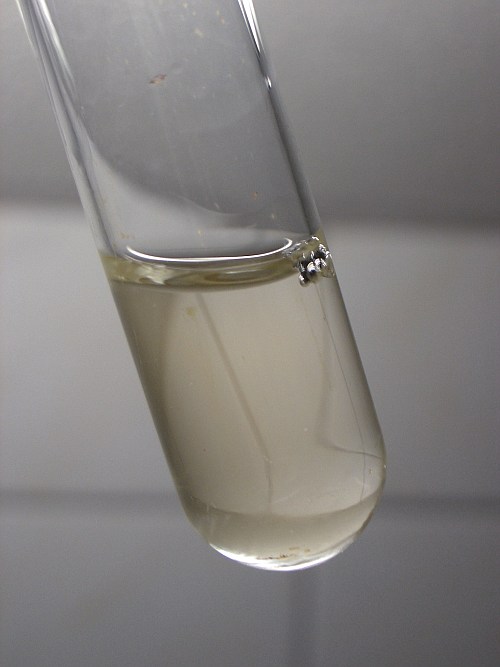
The liquid remains light yellow, and also slightly turbid. The picture above shows a last remain of a piece of selenium, which due to the heat has turned black, and which has bubbles of oxygen on it, due to decomposing peroxodisulfate. The selenium quickly dissolves, what remains most likely is finely dispersed sulphur.
![]() It can nicely be demonstrated that this solution is not
totally clear. When the light of a green laser diode is allowed to pass through
the liquid, then a clearly visible beam of light can be observed, indicating the
presence of larger particles. A clear solution does not show such a beam.
It can nicely be demonstrated that this solution is not
totally clear. When the light of a green laser diode is allowed to pass through
the liquid, then a clearly visible beam of light can be observed, indicating the
presence of larger particles. A clear solution does not show such a beam.
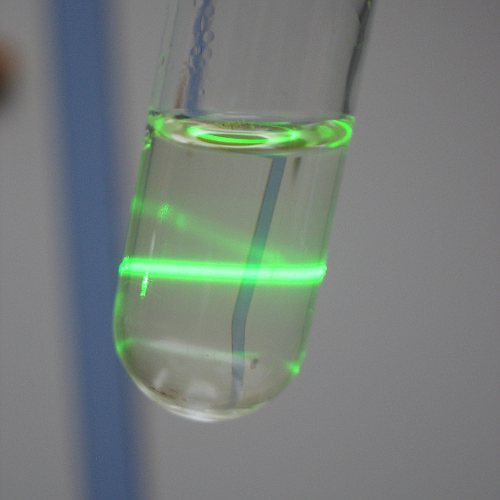
Selenium-sulfide species is stable at very high pH
![]() To the remaining part of the dark red solution (first test
tube picture on this page) a fairly large amount of solid sodium hydroxide was
added and the solid was allowed to dissolve. The liquid heats up considerably
due to the heat of hydration of the sodium hydroxide.
To the remaining part of the dark red solution (first test
tube picture on this page) a fairly large amount of solid sodium hydroxide was
added and the solid was allowed to dissolve. The liquid heats up considerably
due to the heat of hydration of the sodium hydroxide.
![]() When the strongly alkaline solution is added to a large
volume of water, then the liquid remains clear. This is in contrast with the
situation of adding the liquid without sodium hydroxide to a large volume of
water. The picture below shows a beaker to which the alkaline liquid is added.
Due to the higher density of the liquid, it does not completely mix with the
water immediately.
When the strongly alkaline solution is added to a large
volume of water, then the liquid remains clear. This is in contrast with the
situation of adding the liquid without sodium hydroxide to a large volume of
water. The picture below shows a beaker to which the alkaline liquid is added.
Due to the higher density of the liquid, it does not completely mix with the
water immediately.
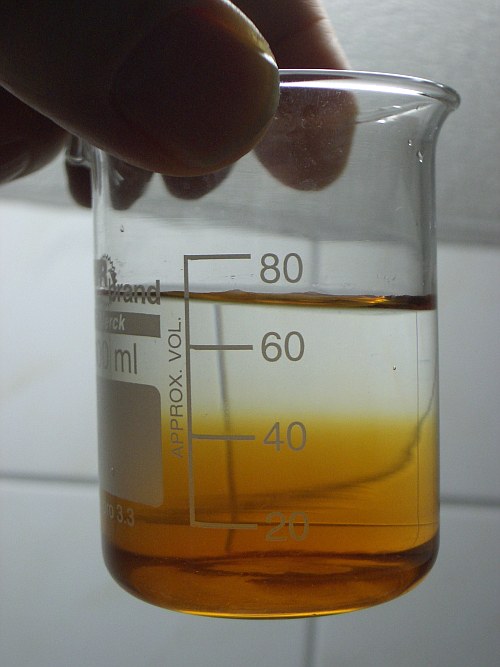
![]() A particularly nice effect is obtained when a small amount of
dilute sulphuric acid is carefully dripped into the middle of beaker. The dilute
acid sinks to the bottom, but at the soft interface between the water and the
brown solution with the selenium-sulfide species in it, a yellow precipitate is
formed, which remains floating in the water, in the interface area. The
precipitate remains there for many minutes, without any visible change.
A particularly nice effect is obtained when a small amount of
dilute sulphuric acid is carefully dripped into the middle of beaker. The dilute
acid sinks to the bottom, but at the soft interface between the water and the
brown solution with the selenium-sulfide species in it, a yellow precipitate is
formed, which remains floating in the water, in the interface area. The
precipitate remains there for many minutes, without any visible change.
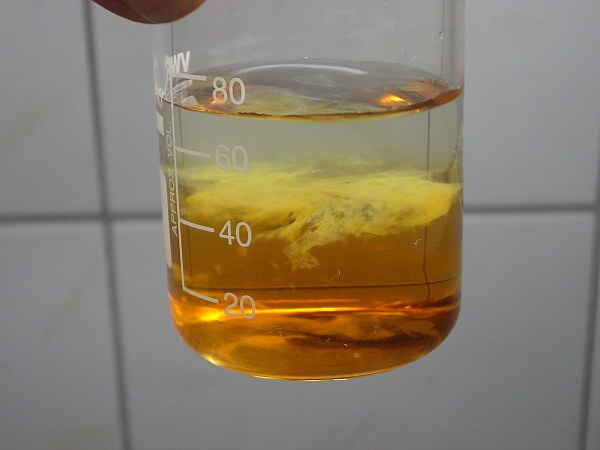
The yellow color most likely is due to the very fine dispersion of the precipitated selenium.
![]() When more acid is added and the contents of the beaker are
stirred with a rod, then the liquid becomes totally opaque and the color of the
liquid becomes like the color of orange juice. This yellow/orange precipitate
either is very finely dispersed selenium, or it is a mix of selenium and
sulphur.
When more acid is added and the contents of the beaker are
stirred with a rod, then the liquid becomes totally opaque and the color of the
liquid becomes like the color of orange juice. This yellow/orange precipitate
either is very finely dispersed selenium, or it is a mix of selenium and
sulphur.
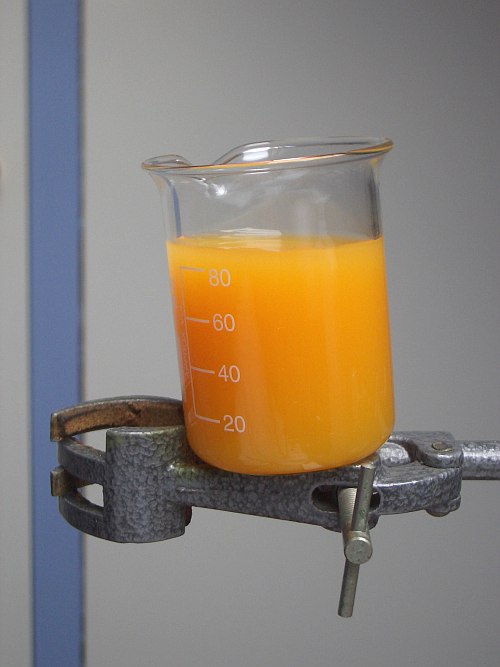
![]()
Part 2: Selenium bromide in aqueous solution
In this part of the experiment, another interesting species of selenium is shown. This is not based on elemental selenium, but on selenious acid, H2SeO3. This acid can be made from selenium dioxide, or from sodium selenite.
Selenious acid forms an intensely colored red species with bromide ion, but only when the concentration of the bromide ion is very high. On dilution with water, the color disappears and a colorless (or pale yellow) solution remains.
Two experiments were carried out. In one experiment, solid Na2SeO3 is added to 40% HBr. In another experiment, solid SeO2 is added to 48% HBr.
Sodium selenite in hydrobromic acid
![]() The first experiment is simply adding solid sodium selenite
to 40% hydrobromic acid. Only a tiny amount of sodium selenite is used, and even
with this tiny amount a fairly intensely colored solution is obtained. The upper
picture shows the solid in a standard test tube, the lower picture shows the
result of adding the 40% hydrobromic acid and briefly swirling the test tube,
until all of the solid has dissolved. A nice red/brown solution is obtained,
which has an intense color. The liquid, sticking to the glass still exhibits a clearly visible yellow color.
The first experiment is simply adding solid sodium selenite
to 40% hydrobromic acid. Only a tiny amount of sodium selenite is used, and even
with this tiny amount a fairly intensely colored solution is obtained. The upper
picture shows the solid in a standard test tube, the lower picture shows the
result of adding the 40% hydrobromic acid and briefly swirling the test tube,
until all of the solid has dissolved. A nice red/brown solution is obtained,
which has an intense color. The liquid, sticking to the glass still exhibits a clearly visible yellow color.
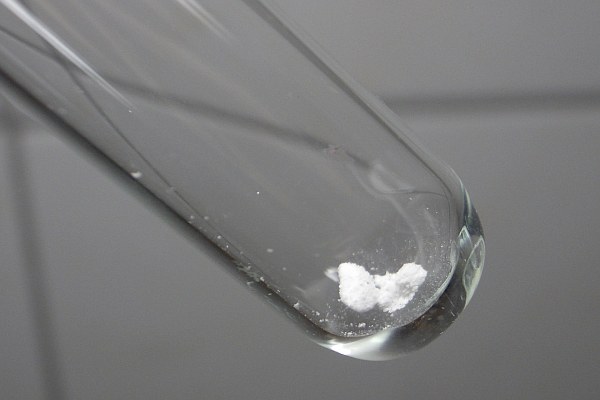
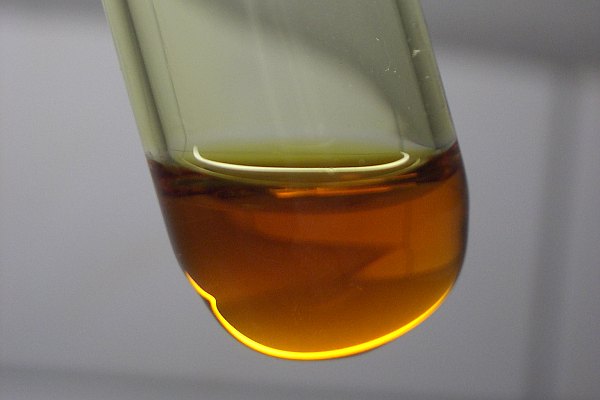
![]() When water is added, even just a small amount, then the color
disappears and the solution becomes pale yellow. The pictures below show the
result of adding a small amount of water, and adding somewhat more water. The
solution does not become totally colorless, a pale yellow color remains and the
liquid also is very slightly turbid. The only explanation for this is that there
is a tiny amount of colloidal selenium in the pale yellow liquid.
When water is added, even just a small amount, then the color
disappears and the solution becomes pale yellow. The pictures below show the
result of adding a small amount of water, and adding somewhat more water. The
solution does not become totally colorless, a pale yellow color remains and the
liquid also is very slightly turbid. The only explanation for this is that there
is a tiny amount of colloidal selenium in the pale yellow liquid.
This is the result of adding a small amount of water and not shaking:
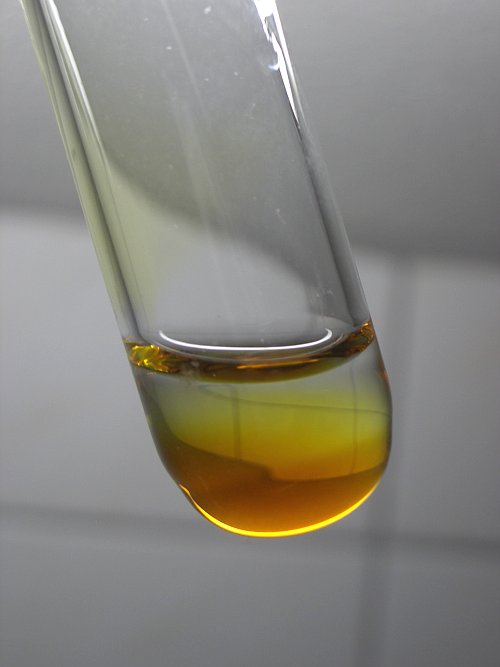
After shaking, the liquid is as follows:
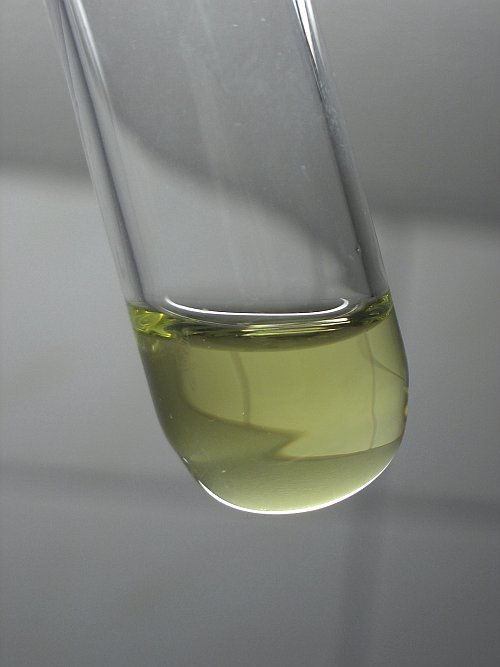
![]() When more water is added, then the yellow color does not
disappear, it just is diluted as expected:
When more water is added, then the yellow color does not
disappear, it just is diluted as expected:
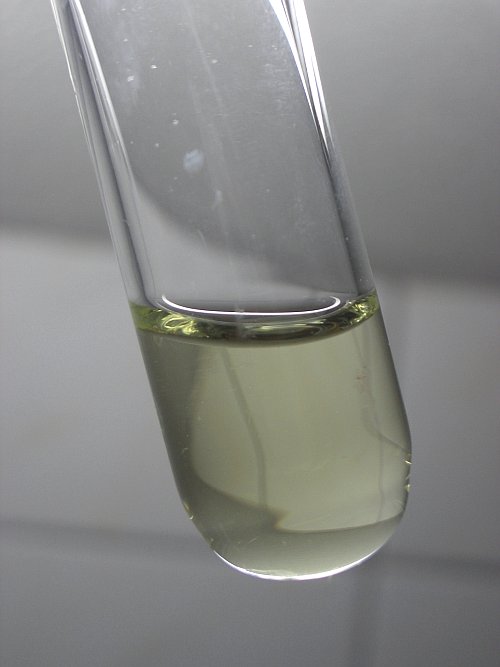
Selenium dioxide in hydrobromic acid
![]() An even deeper color can be obtained from selenium dioxide in
48% hydrobromic acid. This combination of chemicals allows even higher
concentration of bromide and stronger acidity. The two pictures below show how
little selenium dioxide is used and what is the result of adding the hydrobromic
acid.
An even deeper color can be obtained from selenium dioxide in
48% hydrobromic acid. This combination of chemicals allows even higher
concentration of bromide and stronger acidity. The two pictures below show how
little selenium dioxide is used and what is the result of adding the hydrobromic
acid.
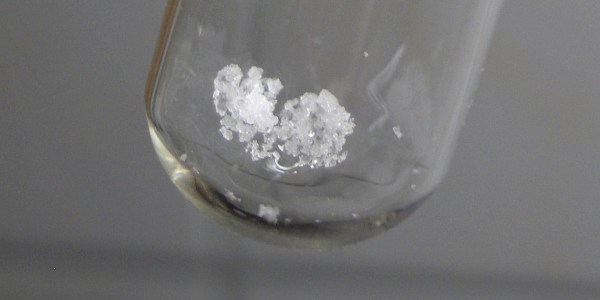
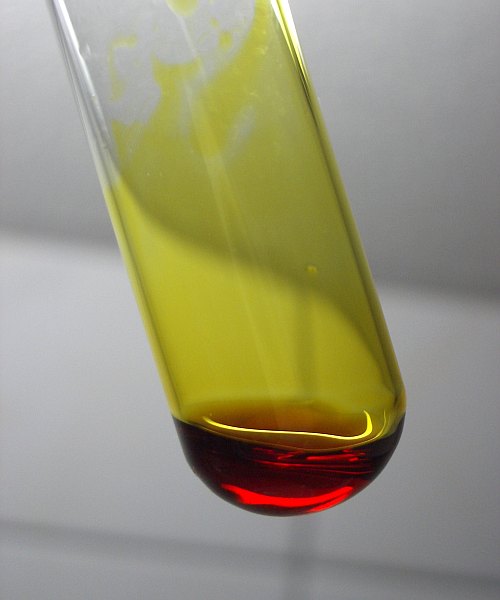
The liquid has a really strong color and the liquid, sticking to the glass shows an intense yellow color, indicating that its color density is high.
![]() When approximately the same volume of water is added to the
deep red liquid, then the liquid almost becomes colorless. The liquid, sticking
to the glass, which is not touched by the water still shows the bright yellow
color.
When approximately the same volume of water is added to the
deep red liquid, then the liquid almost becomes colorless. The liquid, sticking
to the glass, which is not touched by the water still shows the bright yellow
color.
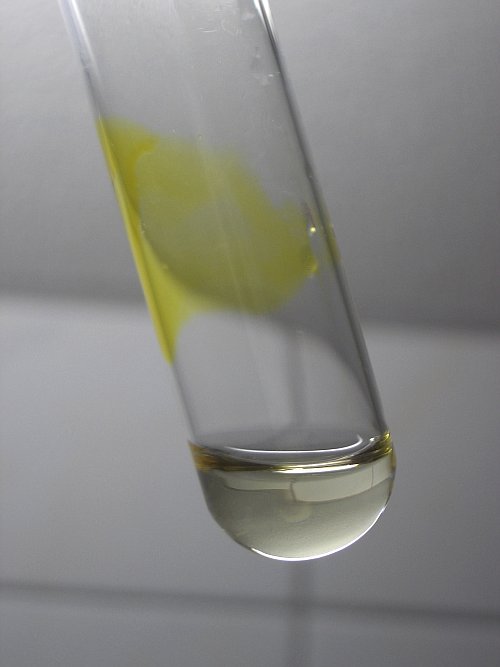
![]() The selenium (which is at oxidation state +4), present in the
hydrobromic acid solution can be reduced very easily. Simply adding some solid
sodium sulfite results in immediate reduction of the selenium to its elemental
form. The coarser pieces of selenium are brick-red, the more finely dispersed
selenium has an orange color:
The selenium (which is at oxidation state +4), present in the
hydrobromic acid solution can be reduced very easily. Simply adding some solid
sodium sulfite results in immediate reduction of the selenium to its elemental
form. The coarser pieces of selenium are brick-red, the more finely dispersed
selenium has an orange color:
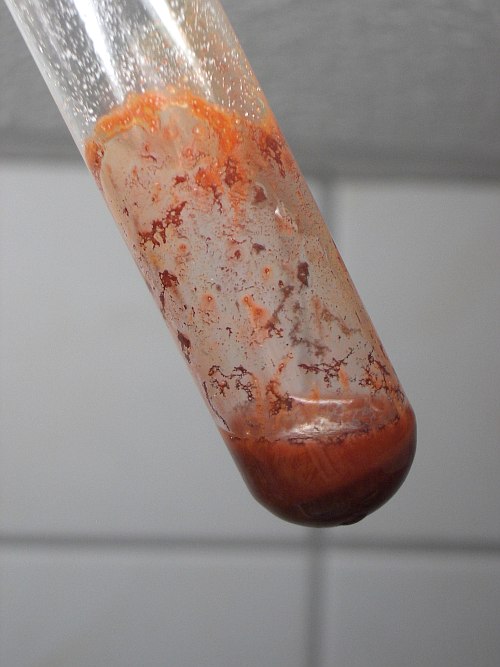
![]()
Discussion of results
The results of these experiments are interpreted by myself,
the author of this webpage, and is not backed up by literature, so take this
explanation with some grains of salt
![]() .
.
Part 1: Selenium in solution of sodium sulfide
![]() In the first experiment, I expect that the reaction
between selenium and the solution of sodium sulfide is very similar to the
reaction of sulphur with a solution of sodium sulfide. A well-known reaction is
the following:
In the first experiment, I expect that the reaction
between selenium and the solution of sodium sulfide is very similar to the
reaction of sulphur with a solution of sodium sulfide. A well-known reaction is
the following:
S2- + nS → Sn+12-
In this reaction, so-called polysulfides are formed. Solutions of polysulfides have a deep golden yellow color. The more sulphur is dissolved in a solution of a sulfide, the deeper the color. The value of n in this equation can be as high as 4 under normal conditions and under more special conditions, according to literature, higher values are reported.
Analogous to the polysulfide reaction, I expect that with selenium the following reaction occurs:
S2- + nSe → SSen2-
The value of n is not known, it most likely equals 1, but more could be possible. Finding out possible values of n requires much more detailed research, in which one determines how much selenium can be dissolved in a solution with a known content of sodium sulfide. The possible range for n almost certainly depends on the concentration of the sulfide.
![]() When a polysulfide solution is acidified, then the polysulfide ions decompose
according to the following equation:
When a polysulfide solution is acidified, then the polysulfide ions decompose
according to the following equation:
Sn+12- + 2H+ → H2Sn+1 → H2S + nS
Most likely, with the selenium-sulfide anionic species the following occurs:
SSen2- + 2H+ → H2S + nSe
As a side reaction, some H2Se and S might be formed as well, but whether this occurs or not must be investigated further. It also must be investigated whether the reaction goes through an intermediate H2SSen or not.
Surprisingly, I could not find any information about such reactions in literature.
Remark: A similar experiment was carried out with tellurium in a solution of sodium sulfide. Tellurium, however, does not react at all. Even after minutes of boiling, no tellurium dissolves and the solution remains colorless.
Part 2: Selenium oxybromide in aqueous solution
![]() When SeO2 or Na2SeO3 is added to an aqueous
acidic solution, then the acid H2SeO3 is formed, which is
a fairly weak acid. This acid reacts with hydrobromic acid, giving a deep
red/brown compound. I think that the following equilibrium reaction occurs:
When SeO2 or Na2SeO3 is added to an aqueous
acidic solution, then the acid H2SeO3 is formed, which is
a fairly weak acid. This acid reacts with hydrobromic acid, giving a deep
red/brown compound. I think that the following equilibrium reaction occurs:
SeO(OH)2 + 2H+ + 2Br– ↔ SeOBr2 + 2H2O
The equilibrium only is to the right when the concentration of bromide and acid is sufficiently high, even at moderate concentration, the equilibrium is at the left for almost 100%.
Literature mentions SeOBr2 as a yellow/red compound, so this matches the observations.
This behavior definitely has no analogue in sulphur chemistry. Both thionylchloride and thionylbromide react vigorously with aqueous solutions and are driven completely towards H2SO3/SO2, even when traces of water are present. Any water is destroyed irreversibly by these compounds and no reverse reaction occurs. Adding SO2 to strong hydrobromic acid certainly does not lead to formation of thionylbromide.
![]() An acidic solution, containing selenium in the +4 oxidation state is
exceptionally easily reduced in the presence of chloride or bromide. A mild
reductor like sulfite (which leads to sulphur dioxide in the acidic medium)
immediately reduces the selenium to its elemental state:
An acidic solution, containing selenium in the +4 oxidation state is
exceptionally easily reduced in the presence of chloride or bromide. A mild
reductor like sulfite (which leads to sulphur dioxide in the acidic medium)
immediately reduces the selenium to its elemental state:
H2SeO3 + 2SO2 + H2O → 2H2SO4 + Se
This reaction only occurs at high speed in the presence of chloride or bromide. So, these ions have some catalytic effect and this most likely has to do with the equilibrium in which SeOCl2 or SeOBr2 is formed.
Reduction of H2SeO3 by SO2 is instantaneous at room temperature, when the reaction is carried out in aqueous HCl or HBr. The reaction only occurs slowly and requires heating when the reaction is carried out in dilute sulphuric acid of similar acidity.